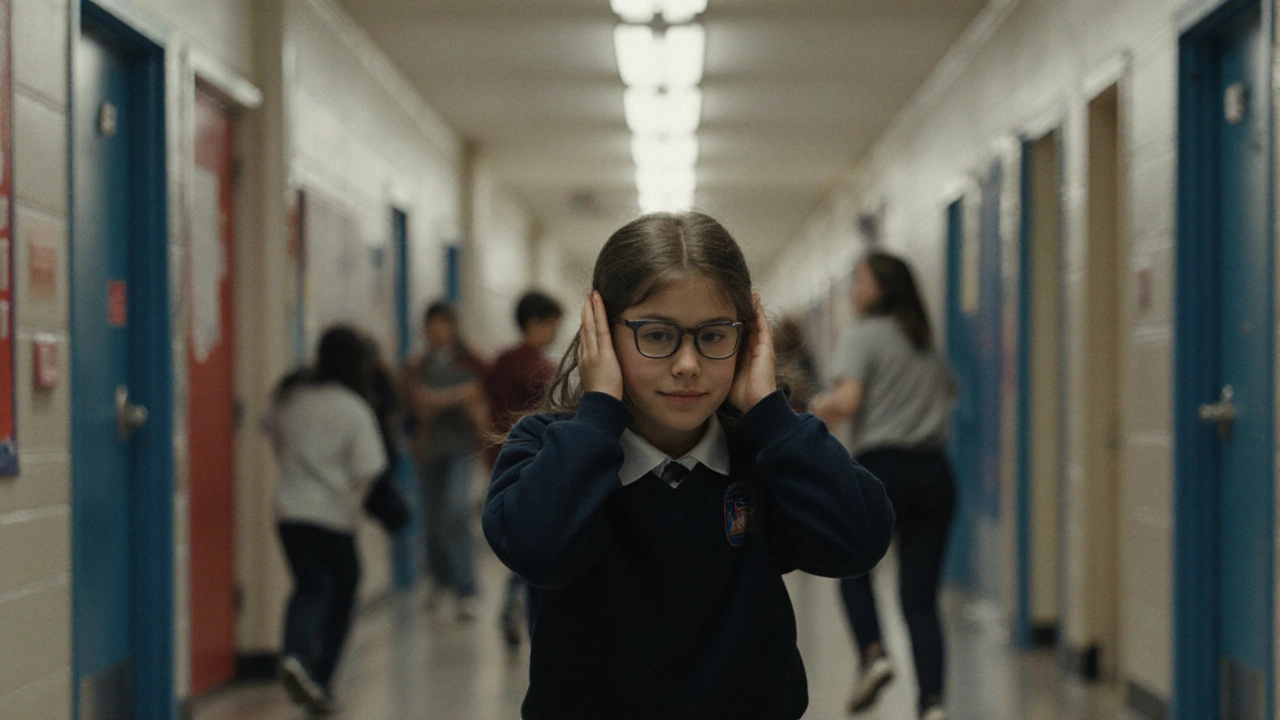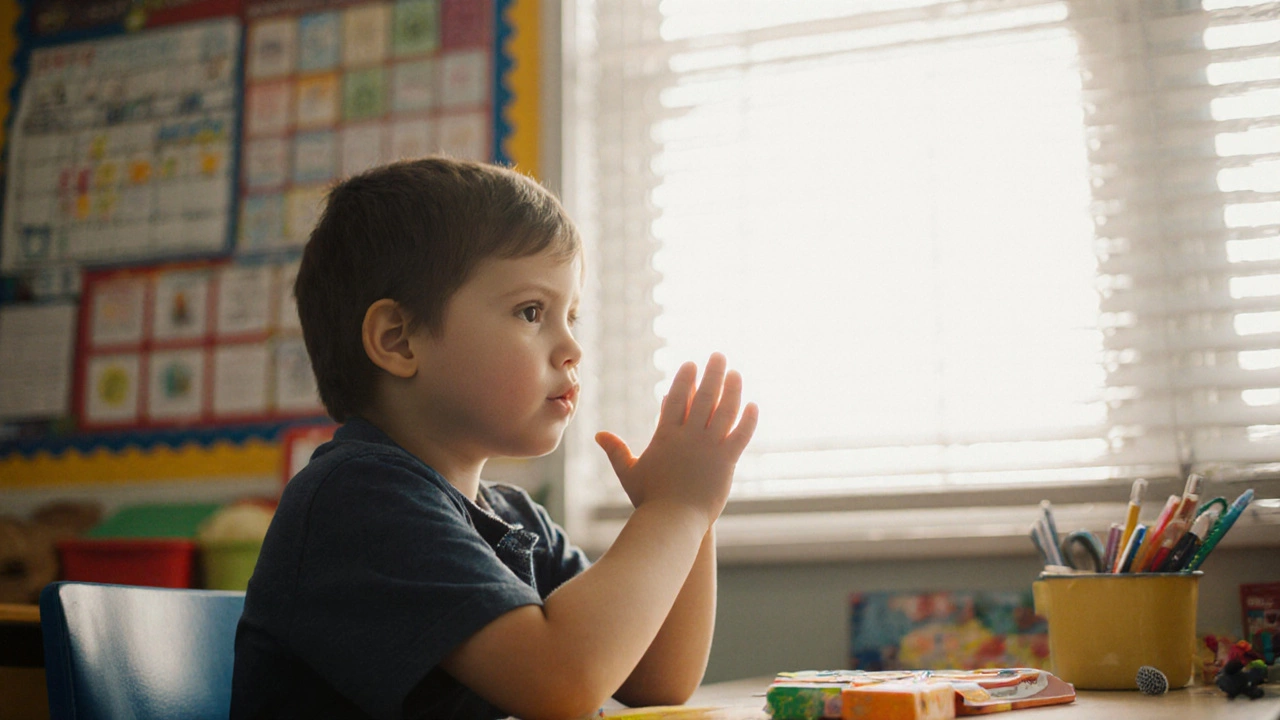When people think about special needs, they often picture learning difficulties or physical disabilities. But one of the most visible and misunderstood parts of special needs is behavior. Not every child with special needs acts out. Not every behavior is defiance. And not every unusual action means the child is being "bad."
What Does a Special Needs Behavior Look Like?
A special needs behavior is any repeated action that stands out from typical development and interferes with learning, social interaction, or safety. These behaviors aren’t random-they’re communication. A child who screams in the grocery store isn’t trying to annoy you. They might be overwhelmed by fluorescent lights, loud announcements, or the texture of the cart handle. A student who covers their ears and runs out of class isn’t being disruptive-they’re trying to escape sensory overload.
Take nonverbal autism, for example. One common behavior is hand-flapping. To an outsider, it looks odd. But for the child, it’s a way to calm their nervous system, regulate emotions, or express excitement. It’s not a problem to fix. It’s a coping tool. When adults try to stop it without understanding why it’s happening, they’re silencing a child’s only way to self-soothe.
Common Examples of Special Needs Behaviors
Here are real, everyday behaviors seen in children with developmental differences:
- Repetitive movements-rocking, spinning, finger-flicking. These are called stimming and help manage anxiety or boredom.
- Resistance to change-meltdowns when the school schedule shifts, even slightly. For many kids with autism or ADHD, predictability is safety.
- Difficulty with eye contact-not because they’re rude, but because looking at someone’s face can be physically overwhelming.
- Food aversions-refusing to eat anything but white foods, or only eating items with a specific texture. This isn’t pickiness. It’s sensory processing disorder.
- Self-injury-head-banging, biting arms. This is a last-resort way to cope with intense pain, frustration, or sensory numbness.
- Running away-bolting from classrooms or stores. Often, it’s not disobedience. It’s an escape response to something too loud, too bright, or too confusing.
These behaviors don’t happen in a vacuum. They’re tied to underlying conditions like autism, ADHD, Down syndrome, intellectual disability, or sensory processing disorder. The same behavior can mean different things for different kids. One child might hit because they’re frustrated they can’t speak. Another might hit because they’re in physical pain from an ear infection and don’t know how to say so.
Why Do These Behaviors Happen?
Most special needs behaviors are rooted in four things: communication, sensory overload, emotional regulation, or lack of skills.
Children with limited verbal abilities often use behavior to say: "I’m scared," "I’m in pain," "I need space," or "I don’t understand." A child who throws books when asked to read? They might not be lazy. They might be terrified they’ll get it wrong and be laughed at.
Sensory issues are huge. A classroom with 30 kids, buzzing lights, squeaky chairs, and a blaring fire drill isn’t just noisy-it’s torture for a child with auditory hypersensitivity. Their brain can’t filter out the noise. So they scream, cover their ears, or shut down.
Emotional regulation is hard for many kids with special needs. Their nervous systems are wired differently. They don’t have the same internal tools to calm down after getting upset. A simple "no" can feel like a catastrophe. What looks like a tantrum is often a full-body panic attack.
And then there’s skill gaps. A child might not know how to ask for help, take turns, or wait in line. They haven’t learned those skills yet. That doesn’t mean they’re defiant. It means they need instruction-not punishment.

What Happens When You Misinterpret These Behaviors?
Too often, schools and families respond with discipline. Time-outs. Detentions. Suspensions. Yelling. These approaches make things worse.
A 2023 study by the National Center for Learning Disabilities found that children with autism are three times more likely to be suspended than their neurotypical peers-even for the same behavior. Why? Because adults assume the child is choosing to misbehave. They’re not. They’re reacting to an environment that doesn’t work for them.
Imagine being trapped in a room where every sound feels like nails on a chalkboard, the lights hurt your eyes, and no one understands you when you try to speak. Then, when you cover your ears and cry, you’re sent to the principal’s office. That’s not justice. That’s cruelty disguised as discipline.
When you punish a behavior without understanding its cause, you teach the child that the world is unsafe and they’re broken. You don’t teach them how to cope. You teach them to hide, to shut down, or to fight harder.
What Should You Do Instead?
Start by asking: "What is this behavior trying to tell me?"
Here’s how to respond effectively:
- Observe and record-When does it happen? Where? Who’s around? What happened right before? Keep notes for a week. Patterns will show up.
- Remove the trigger-If the child melts down every time the fire alarm tests, give them noise-canceling headphones or let them leave the room during drills.
- Teach replacement skills-If a child hits when frustrated, teach them to use a picture card that says "I need help" or to tap a stress ball.
- Build predictability-Use visual schedules. Let them know what’s coming next. Even small changes can be terrifying.
- Collaborate with specialists-Occupational therapists, speech therapists, and behavior analysts can help decode behavior and create support plans.
One teacher I spoke with started giving her nonverbal student a small fidget toy during reading time. The child used to scream and crawl under the desk. After three weeks with the toy, the meltdowns dropped by 80%. The toy wasn’t the fix-it was the bridge to calm.

It’s Not About Fixing Behavior. It’s About Understanding the Person.
Special needs behaviors aren’t flaws to correct. They’re clues. Every scream, every meltdown, every withdrawal is a message from someone who’s struggling to survive in a world not built for them.
The goal isn’t to make the child act "normal." The goal is to make the environment work for them. That means adjusting lighting, noise levels, schedules, expectations, and communication methods. It means listening more and judging less.
When we stop seeing behavior as defiance and start seeing it as communication, everything changes. The child feels seen. The adult feels less frustrated. And learning becomes possible again.
What Happens When You Get It Right?
One school district in Oregon started training all staff in trauma-informed, behavior-support practices. Within two years, suspensions for students with special needs dropped by 62%. Attendance went up. Teacher burnout went down. And the kids? They started smiling in class.
It’s not magic. It’s just basic human respect.
Special needs behaviors aren’t the problem. The lack of understanding is.
Is hand-flapping a sign of autism?
Hand-flapping can be a sign of autism, but it’s not always. Many neurotypical children stim too-especially when excited or tired. In autism, it’s often more frequent, intense, and used as a self-regulation tool. The key is context: Is it happening often? Does it interfere with learning or safety? If not, it’s just a way the child manages their energy.
Can special needs behaviors be outgrown?
Some behaviors fade as a child grows and learns better coping strategies. Others, like stimming or needing routine, may continue into adulthood-but they don’t need to be eliminated. The goal isn’t to make someone "normal." It’s to help them thrive. With support, many people with special needs learn to manage their behaviors in healthy ways, like using noise-canceling headphones instead of covering their ears, or carrying a stress ball instead of biting their hands.
Are special needs behaviors always linked to a diagnosis?
No. Some children show behaviors that look like those linked to autism or ADHD but don’t meet full diagnostic criteria. That doesn’t mean their needs are any less real. Many kids benefit from support-even without a formal label. If a behavior is causing distress or blocking learning, it deserves attention, not waiting for paperwork.
What’s the difference between a tantrum and a meltdown?
A tantrum is goal-driven-like a child screaming because they want candy. They’ll stop if they get what they want or if they see they’re not getting attention. A meltdown is a nervous system overload. It’s not about getting something. It’s about being overwhelmed. The child isn’t in control. They can’t calm down just because you say "stop." They need safety, space, and time.
Can a child with special needs behave "normally" in some settings?
Yes. Many kids mask their behaviors at school to fit in, then have meltdowns at home because they’re exhausted from pretending. Others behave well at home but fall apart in loud, crowded places. Behavior changes based on environment-not because the child is being "good" or "bad." It’s about what their nervous system can handle in that moment.
Next Steps: What to Do Today
If you’re a parent, teacher, or caregiver wondering how to help:
- Start a behavior log. Note time, place, trigger, and what happened after.
- Reduce sensory triggers one at a time-dim lights, lower volume, offer quiet spaces.
- Learn one new communication tool: picture cards, a simple app, or a hand signal for "I need a break."
- Ask the child, "What would help you right now?" Even if they can’t answer, asking shows you care.
- Reach out to a school psychologist or occupational therapist. You don’t have to figure this out alone.
Understanding special needs behavior isn’t about memorizing a list of symptoms. It’s about learning to listen with your whole attention-not just your ears. The child is speaking. Are you ready to hear them?

